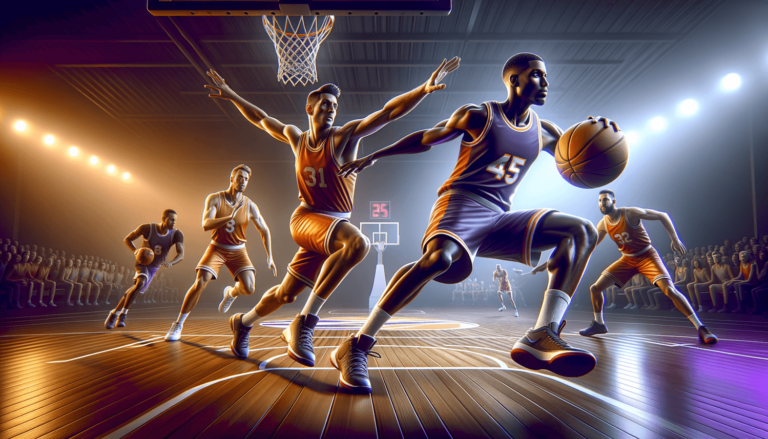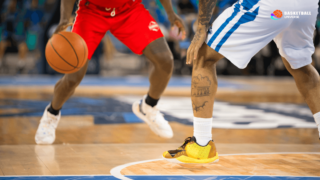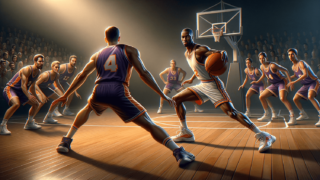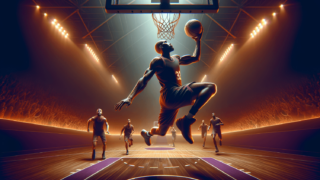
Get ready to explore one of the most thrilling and essential maneuvers in the fast-paced world of basketball: the drive and dish! Through this blog post, you’ll be diving head-first into the intricate world of this exciting play, dissecting the role it plays in transforming average offenses into scoring powerhouses. Even if you’re new to the sport or a seasoned enthusiast, our entertaining yet professional approach guarantees an enriching experience for everyone. So, let’s lace up our basketball shoes, hit the court, and uncover the magic behind the drive and dish!
What’s a Drive and Dish in Basketball?
A drive and dish in basketball refers to an offensive strategy where a player dribbles towards the basket, drawing in defenders, and then passes the ball to a teammate for an open shot. This maneuver capitalizes on the defense’s focus on the driving player, creating opportunities for uncontested shots or higher-percentage scoring chances for the team.
Mastering the Art of Drive and Dish
Whether you’re a steadfast basketball enthusiast or just starting your journey into the mesmerizing world of this sport, the drive and dish is an essential tactic to understand and incorporate into your play. In the following sections, we will delve deeper into the intricacies of the drive and dish, shedding light on why it’s a favorite offensive weapon for many teams and how you can start mastering it today!
The Three Key Components of Drive and Dish
Every effective drive and dish technique revolves around three main components: the ball handler, the driving lane, and the receiving teammate. We’ll dissect each element, enabling you to better appreciate the synergy required for this basketball strategy to work seamlessly.
1. The Ball Handler
The ball handler’s role is crucial in initiating and executing the drive and dish. They must possess strong dribbling skills, speed, and court vision to evade defenders, find open teammates, and make the right decisions under pressure. Good ball handlers also have a keen understanding of their teammates and their shooting abilities, ensuring the ball is passed to the player with the highest chance of scoring. Point guards usually excel in this role, but other positions can also demonstrate exceptional ball-handling skills.
2. The Driving Lane
Creating a driving lane is essentially finding an open path to the basket that the ball handler can penetrate. Clever offensive spacing and off-ball movement by teammates help generate driving lanes by drawing defenders away from the desired path. Similarly, well-timed screens and cuts can force defenders to momentarily lose focus, providing ample room for the ball handler to penetrate the paint.
3. The Receiving Teammate
The receiving teammate’s primary role during the drive and dish is to offer the ball handler a viable outlet for a pass. They must maintain proper spacing, demonstrate sound shooting skills, and possess the intuition to identify scoring opportunities as they present themselves. As the ball handler drives, the receiver should simultaneously reposition themselves to create an open passing lane and stay ready for a catch-and-shoot opportunity.
How Defense Shapes the Drive and Dish
Understanding the defensive nuances and rotations is crucial for executing the drive and dish efficiently. To help demystify the defense’s role in enabling the success or failure of this basketball tactic, let’s discuss a few crucial factors that come into play.
1. Defensive Pressure
Defensive pressure can heavily impact the decision-making process for the ball handler. If their defender is playing tight or aggressively, it can force the ball handler to drive sooner or change their intended driving lane. The ball handler must be able to read the defender’s positioning, adapt accordingly, and react to any openings created as a result of the pressure.
2. Help Defense
When the ball handler initiates the drive, help defenders inevitably shift their focus and crash down to prevent an easy basket. Excellent ball handlers seize this opportunity by using the driving motion to draw in multiple defenders, leaving the receiving teammate wide-open for a pass. Deciphering the help defense’s movements and recognizing pass opportunities are critical for a successful drive and dish execution.
3. Defensive Rotations
Mastering the drive and dish also involves anticipating defensive rotations. As help defenders collapse onto the driving player, other defenders may rotate to cover the receiving teammate, attempting to close down open shot opportunities. Reacting to these rotations effectively requires collaboration and chemistry between the ball handler and the receiving teammate, ensuring they choose the optimal passing and shooting decisions.
Injecting Efficiency Into Your Drive and Dish Game
Now that you’re growing familiar with the many facets of this powerful basketball move, let’s look at a few practical tips and exercises to help you and your team incorporate the drive and dish tactic into your offensive game plan.
1. One-on-One Practice Drills
Working on your individual skills is crucial to becoming a more efficient drive and dish player. As a ball handler, focus on strengthening your dribbling, speed, and agility with exercises such as zig-zag dribbling drills, speed ladder workouts, and cone weave sprints. On the other hand, receiving teammates should constantly improve their shooting accuracy with shooting drills, as well as practice their spatial awareness and off-ball movement on the court.
2. Team Drills
Once individual skills are honed, practicing as a team is invaluable for developing chemistry and understanding between the ball handler and the receiving teammate. Drive and dish drills can range from simple two-player exercises to more complex multi-player scenarios, focusing on timing, communication, and decision-making. Employing these drills during practice sessions will bolster your team’s drive and dish aptitude, adding a new dimension to your offensive repertoire.
3. Studying Opposing Defenses
Scouting opposing team’s defensive tendencies can provide valuable insights into when and how to exploit the drive and dish tactic. Identifying defensive weak spots and predicting rotation patterns can help your team devise strategies to maximize open shot opportunities. Watching game footage, discussing tactics with coaches, and being vigilant during games are all essential steps to stay ahead of the competition.
A Versatile Tactic for All Offensive Systems
While the drive and dish is a powerful offensive move on its own, it can also be seamlessly integrated into various offensive systems and play styles. Let’s explore a few scenarios where the drive and dish tactic can fit flawlessly within different basketball strategies.
1. Fast Breaks
In fast break situations, ball handlers often drive and penetrate the paint, drawing defenders and creating open shot opportunities for trailing teammates. Drive and dish is a perfect complement to fast break basketball, as the increased pace and defensive confusion provide ample scoring chances for teams that capitalize on the chaos.
2. Pick and Roll Offense
The pick and roll offense is a time-tested basketball strategy that opens up space for the ball handler to drive. Once the ball handler has penetrated the defense, they can choose to either finish at the rim or dish the ball out to an open teammate for a shot. The drive and dish tactic enhances the pick and roll offense by providing additional scoring options and keeping defenses guessing at all times.
3. Spread Offense
Teams that operate with a spread offense attempt to stretch the floor by keeping their players spaced out around the perimeter. This often creates driving lanes for the ball handler, who can exploit these gaps with a drive and dish maneuver. In this scenario, the receiving teammate typically has ample room for an uncontested shot, as defenders scramble to recover from the driving player’s penetration.
Adapting to Different Game Situations
A key aspect of the drive and dish is its adaptability to varying game situations. The effectiveness of this basketball move can surge or wane depending on various factors such as score, time remaining, game tempo, and opposing team composition. Recognizing when to utilize the drive and dish and when to opt for alternative strategies takes experience and a profound understanding of the game.
1. Score and Game Tempo
When a team is trailing or facing a high-pressure scenario, relying on the drive and dish can be an effective means to stump the opposing defense and generate quick points. On the other hand, when defending a significant lead, teams may prefer slowing down the tempo instead of aggressively pursuing the basket, focusing more on ball protection and minimizing turnovers.
2. Opposing Team Composition
Playing against a team with a strong paint presence can make the drive and dish tactic more challenging, as dominant shot-blockers will likely disrupt the ball handler’s penetration. However, as defenses converge to protect the paint, it can create open opportunities for perimeter shooters. Being able to gauge your team’s strengths and weaknesses in relation to the opposition’s is vital for the effective utilization of the drive and dish.
3. Time and Situation Management
Lastly, understanding the game clock and overall situation will impact the relevance of the drive and dish tactic. For example, during a tight game with limited time remaining, a team might prioritize getting the ball to their star player for a last-second shot, rather than relying on a drive and dish attempt. However, if the defense collapses onto the star player, a well-timed drive and dish could be the perfect counter to secure a victory.
Embracing the many layers and complexities of the drive and dish technique can significantly boost a team’s offensive firepower, transforming them into a formidable force on the basketball court. By understanding the dynamics of this move, refining individual and team skills, and implementing it strategically, players and teams can unlock their full potential and elevate their game to new heights.
Embracing Variations: Drive and Kick
In addition to the classic drive and dish technique, there are other variations that can be highly effective when incorporated into your team’s offensive plan. One such variation is the “drive and kick,” which has become increasingly popular in today’s fast-paced, perimeter-oriented basketball. Let’s take a closer look at this strategic move and how it compares to the traditional drive and dish.
Understanding the Drive and Kick
The drive and kick follows a similar pattern to the drive and dish, with a key difference in the type of pass executed by the ball handler. In the drive and kick, the ball handler deliberately attempts to penetrate the defense and reach the perimeter of the paint. As their driving motion attracts help defenders, the ball handler kicks the ball out to an open teammate positioned behind the three-point line, ready for a catch-and-shoot opportunity.
How It Compares to the Drive and Dish
While both the drive and dish and the drive and kick capitalizes on the ball handler’s ability to break down defenses and create space for teammates, there are notable differences in their approach and execution:
- Target Area: The drive and dish typically looks to pass the ball to a teammate who’s open in the paint, close to the basket, or in the mid-range area. In contrast, the drive and kick orchestrates a pass to a teammate positioned on the three-point line, primed for a long-range shot.
- Shot Selection: As drive and kick passes are specifically designed for three-point attempts, this tactic tends to promote an emphasis on perimeter shooting. On the other hand, drive and dish creates varied scoring opportunities, ranging from layups and dunks to mid-range jump shots.
- Spacing: The drive and kick often requires a wider spacing and clear passing lanes to ensure the kicked-out pass reaches an open three-point shooter. This contrasts the drive and dish, which can operate effectively in tighter spaces and more congested areas of the court.
By combining the drive and dish with its variations like the drive and kick, teams can expand their offensive arsenal and create diverse scoring opportunities, keeping defenses on their toes and more effectively exploiting their weaknesses.
Frequently Asked Questions
In this section, we answer ten frequently asked questions related to the drive and dish technique and its variations, offering insights and clarification to help deepen your understanding of this basketball tactic. These questions cover a range of topics, from fundamental concepts to more nuanced aspects of the drive and dish, providing well-rounded knowledge for readers.
1. Can any player execute a drive and dish?
While any player with adequate ball-handling skills and court vision can potentially execute a drive and dish, it is most commonly performed by point guards and other backcourt players due to their superior dribbling abilities and playmaking responsibilities.
2. How can I improve my decision-making during a drive and dish?
Improving decision-making during a drive and dish can be achieved through practice, watching game footage, learning defensive tendencies, and developing chemistry with your teammates. The more you understand the nuances of the game and the more experience you accumulate, the better equipped you’ll be to make the right decisions on the court.
3. Why is the drive and dish so effective?
The drive and dish is highly effective because it capitalizes on the defense’s natural instinct to collapse on a driving player to protect the basket. This reaction creates open space for the receiving teammate, providing uncontested or high-percentage scoring opportunities which can be exploited with well-timed passes.
4. Is the drive and dish only applicable in transition or fast break situations?
No, the drive and dish can be employed in various offensive situations, including half-court settings, pick-and-roll or pick-and-pop plays, and spread offenses. It’s a versatile tactic that can be integrated into multiple offensive systems to maximize scoring opportunities.
5. How can defenses counter the drive and dish?
Defenses can counter the drive and dish by maintaining tight on-ball defense on the ball handler, employing effective help-side defense rotations, and focusing on quick closeouts to contest open shots. Additionally, studying the opposing team’s offensive tendencies and communication between defenders can also help neutralize the drive and dish threat.
6. What is the difference between a drive and dish and a drive and kick?
The primary difference between the two is the target area for the pass. In a drive and dish, the ball handler typically passes to a teammate in the paint or mid-range area, while in a drive and kick, the pass targets a teammate positioned behind the three-point line for a long-range shot opportunity.
7. Can the drive and dish be used in isolation plays?
Yes, the drive and dish can be utilized in isolation plays, where the ball handler aims to beat their defender one-on-one and penetrate the defense. As help defenders converge on the driving player, the ball handler can create an open shot for a teammate by executing a well-timed pass out of the isolation move.
8. How can I practice the drive and dish with my teammates?
You can practice the drive and dish with your teammates by performing team drills designed to focus on timing, communication, and decision-making. These drills can range from simple two-player exercises to more complex multi-player scenarios, and should emphasize collaboration and court awareness in addition to individual skills.
9. What kind of player is best suited for the receiving teammate role in a drive and dish play?
A receiving teammate in a drive and dish play should ideally possess excellent court awareness, proficient shooting skills, and the ability to quickly reposition themselves on the court for an open shot opportunity. Both frontcourt and backcourt players can excel in this role, provided they have the skill set to capitalize on the created scoring opportunities.
10. Can the drive and dish be effective against zone defense systems?
Yes, the drive and dish can be effective against zone defenses as well. By exploiting gaps in the zone and causing defenders to collapse on the driving player, the drive and dish can create open shot opportunities for teammates positioned in weak points of the zone defense. However, proper timing and execution are especially crucial against zone defenses due to their focus on covering specific areas of the court.
Featured Posts
- No pillar pages found.





